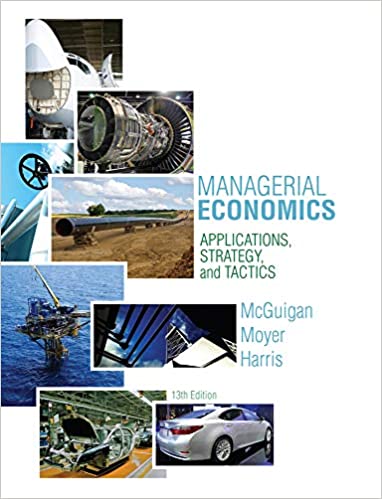
Managerial Economics 13th Edition by James McGuigan,Charles Moyer,Frederick Harris
Edition 13ISBN: 978-1285420929
Managerial Economics 13th Edition by James McGuigan,Charles Moyer,Frederick Harris
Edition 13ISBN: 978-1285420929 Exercise 21
Based on the scatter diagram in Question, what kind of mathematical relationship would appear to exist between enrollment and operating expenditures per student In other words, do operating expenditures per student appear to (i) be constant (and independent of enrollment), (ii) follow a linear relationship as enrollment increases, or (iii) follow some sort of nonlinear U-shape (possibly quadratic) relationship as enrollment increases
As part of this study, the following cost function was developed:
C = f(Q, X 1 , X 2 , X 3 , X 4 , X 5 )
where C = operating expenditures per student in average daily attendance (measured in dollars)
Q = enrollment (number of students in average daily attendance)
X 1 = average teacher salary
X 2 = number of credit units ("courses") offered
X 3 = average number of courses taught per teacher
X 4 = change in enrollment between 1957 and 1960
X 5 = percentage of classrooms built after 1950
Variables X 1 , X 2 , and X 3 were considered measures of teacher qualifications, breadth of curriculum, and the degree of specialization in instruction, respectively. Variable X 4 measured changes in demand for school services that could cause some lagging adjustments in cost. Variable X 5 was used to reflect any differentials in the costs of maintenance and operation due to the varying ages of school properties. Statistical data on 109 selected high schools yielded the following regression equation:

Notes: The numbers in parentheses are the t-scores of each of the respective (b) coefficients. An asterisk (*) indicates that the result is statistically significant at the 0.01 level.
Question
Plot the data in columns B and C in an output (enrollment-) cost graph and sketch a smooth curve that would appear to provide a good fit to the data.
As part of this study, the following cost function was developed:
C = f(Q, X 1 , X 2 , X 3 , X 4 , X 5 )
where C = operating expenditures per student in average daily attendance (measured in dollars)
Q = enrollment (number of students in average daily attendance)
X 1 = average teacher salary
X 2 = number of credit units ("courses") offered
X 3 = average number of courses taught per teacher
X 4 = change in enrollment between 1957 and 1960
X 5 = percentage of classrooms built after 1950
Variables X 1 , X 2 , and X 3 were considered measures of teacher qualifications, breadth of curriculum, and the degree of specialization in instruction, respectively. Variable X 4 measured changes in demand for school services that could cause some lagging adjustments in cost. Variable X 5 was used to reflect any differentials in the costs of maintenance and operation due to the varying ages of school properties. Statistical data on 109 selected high schools yielded the following regression equation:

Notes: The numbers in parentheses are the t-scores of each of the respective (b) coefficients. An asterisk (*) indicates that the result is statistically significant at the 0.01 level.
Question
Plot the data in columns B and C in an output (enrollment-) cost graph and sketch a smooth curve that would appear to provide a good fit to the data.
Explanation
Smooth curves that appear to provide a g...
Managerial Economics 13th Edition by James McGuigan,Charles Moyer,Frederick Harris
Why don’t you like this exercise?
Other Minimum 8 character and maximum 255 character
Character 255


